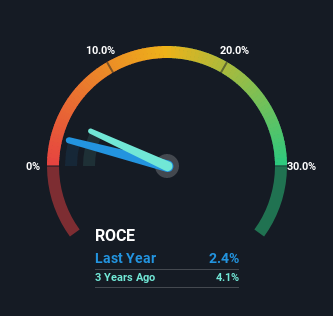The Returns On Capital At mDR (SGX:Y3D) Don't Inspire Confidence
Did you know there are some financial metrics that can provide clues of a potential multi-bagger? Firstly, we'll want to see a proven return on capital employed (ROCE) that is increasing, and secondly, an expanding base of capital employed. If you see this, it typically means it's a company with a great business model and plenty of profitable reinvestment opportunities. Having said that, from a first glance at mDR (SGX:Y3D) we aren't jumping out of our chairs at how returns are trending, but let's have a deeper look.
Understanding Return On Capital Employed (ROCE)
For those who don't know, ROCE is a measure of a company's yearly pre-tax profit (its return), relative to the capital employed in the business. To calculate this metric for mDR, this is the formula:
Return on Capital Employed = Earnings Before Interest and Tax (EBIT) ÷ (Total Assets - Current Liabilities)
0.024 = S$3.6m ÷ (S$217m - S$69m) (Based on the trailing twelve months to June 2022).
So, mDR has an ROCE of 2.4%. Ultimately, that's a low return and it under-performs the Electronic industry average of 9.6%.
Our analysis indicates that Y3D is potentially undervalued!

While the past is not representative of the future, it can be helpful to know how a company has performed historically, which is why we have this chart above. If you want to delve into the historical earnings, revenue and cash flow of mDR, check out these free graphs here.
How Are Returns Trending?
On the surface, the trend of ROCE at mDR doesn't inspire confidence. Around five years ago the returns on capital were 5.7%, but since then they've fallen to 2.4%. And considering revenue has dropped while employing more capital, we'd be cautious. This could mean that the business is losing its competitive advantage or market share, because while more money is being put into ventures, it's actually producing a lower return - "less bang for their buck" per se.
Our Take On mDR's ROCE
In summary, we're somewhat concerned by mDR's diminishing returns on increasing amounts of capital. We expect this has contributed to the stock plummeting 80% during the last five years. Unless there is a shift to a more positive trajectory in these metrics, we would look elsewhere.
mDR does have some risks, we noticed 3 warning signs (and 1 which shouldn't be ignored) we think you should know about.
While mDR isn't earning the highest return, check out this free list of companies that are earning high returns on equity with solid balance sheets.
New: AI Stock Screener & Alerts
Our new AI Stock Screener scans the market every day to uncover opportunities.
• Dividend Powerhouses (3%+ Yield)
• Undervalued Small Caps with Insider Buying
• High growth Tech and AI Companies
Or build your own from over 50 metrics.
Have feedback on this article? Concerned about the content? Get in touch with us directly. Alternatively, email editorial-team (at) simplywallst.com.
This article by Simply Wall St is general in nature. We provide commentary based on historical data and analyst forecasts only using an unbiased methodology and our articles are not intended to be financial advice. It does not constitute a recommendation to buy or sell any stock, and does not take account of your objectives, or your financial situation. We aim to bring you long-term focused analysis driven by fundamental data. Note that our analysis may not factor in the latest price-sensitive company announcements or qualitative material. Simply Wall St has no position in any stocks mentioned.
About SGX:Y3D
mDR
An investment holding company, engages in the distribution and retail of telecommunication products and services in Singapore and Malaysia.
Adequate balance sheet second-rate dividend payer.
Market Insights
Community Narratives



